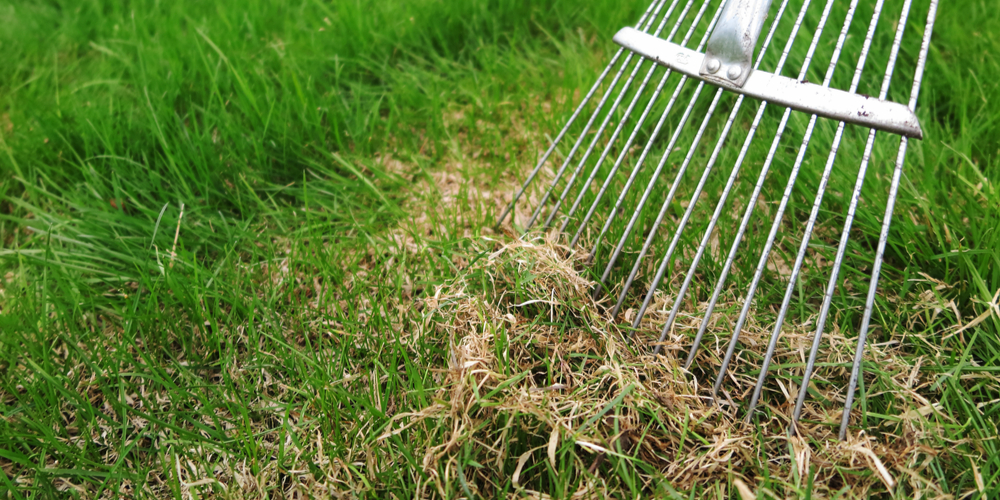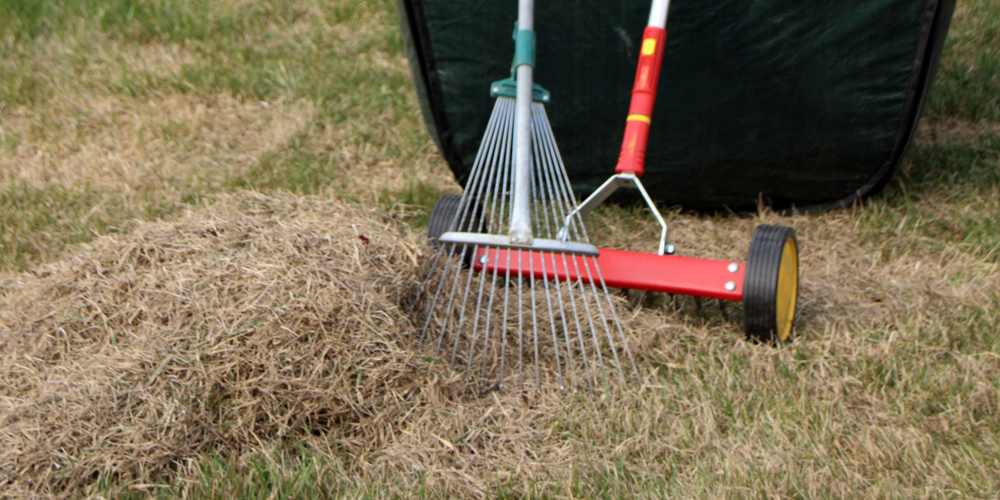Thatch is the term used to describe the layer of both dead and living organic matter that collects on top of your lawn. This material is composed of things like clippings, grass, and even small roots. A little bit of thatch is good for your lawn because it acts as a cushion, helps hold moisture, and provides insulation from extremes in temperature. You may be wondering how to go about dethatching after rain.
Like anything else, thatch build-up can become excessive, and when it does, it can cause problems for your lawn. Excessive thatch can create a hospitable environment for pests and diseases, make it difficult for water and nutrients to reach the grassroots, and promote turfgrass scalping.
The question is: can you dethatch anytime? Let’s learn more about the process and why you should (or shouldn’t) dethatch after the rain.
The Importance of Dethatching

Dethatching is the process of removing the built-up thatch from your lawn. The goal is to remove enough thatch so that it no longer poses a problem for your lawn, but not so much that you damage the turfgrass.
It is considered an important cultural practice because it helps reduce thatch build-up, improve turfgrass health, and enhance the beauty of your lawn. Doing so allows thatch to rob potential nutrients and moisture from the ground.
However, if you have just irrigated your lawn or rain has passed, you should hold off dethatching. Drenched grass is more vulnerable to irreversible damage. Doing so can rip off too much of the thatch and lawn grass, which will undoubtedly set your lawn back.
Dethatching After Rain: Reasons Why You Shouldn’t Do It
Dethatching is a crucial step in lawn care, but you shouldn’t do it right after it rains. Here are some reasons why:
Can Damage Grass Roots
The roots of the grass are what give the plant the strength to stand upright and produce new growth. If you dethatch when the ground is too wet, you run the risk of damaging or even ripping out these roots. This can harm your lawn and make it more susceptible to disease and pests.
Unfortunately, this damage may not be immediately apparent. It could take days or even weeks for the full extent of the damage to show up. By then, it may be too late to save your lawn.
Too Much Thatch Removal
As we mentioned before, thatch is beneficial for your lawn up to a certain point. If you remove too much of it, you can do more harm than good. This is because thatch provides insulation and helps hold moisture in the soil.
Without enough thatch, your lawn will be more susceptible to drought stress and heat damage. In extreme cases, too much thatch removal can even kill your grass.
Can Create Soil Compaction
Soil compaction is another issue you may face if you dethatch when the ground is too moist. This happens when the machine’s weight presses down on the wet soil, causing it to compact. The fact that the thatch and drenched grasses are already adding weight to the ground makes it more susceptible to compaction.
This can lead to several problems, such as poor drainage, difficulty in root growth, and an unhealthy lawn.
Can Promote Turfgrass Scalping
Turfgrass scalping is when you remove too much of the thatch and grass, exposing the soil beneath. This can happen if you set the machine too low or if the ground is too wet.
May Cause Dethatcher to Clog
If you try to dethatch when the ground is too wet, you may find that your machine clogs up quickly. This is because the wet thatch and grass can get caught in the teeth of the dethatcher, making it difficult to move and operate.
Aside from being a nuisance, a clogged machine can also damage your lawn. The blades can tear up the grass if they get stuck, causing irreparable damage.
When is the Best Time to Dethatch?
Dethatching your lawn can provide multiple benefits, given that you do it at the right time. The best time to do this is when the grass is actively growing. For warm-season grasses, you can dethatch during the late spring and all throughout the early summer weeks. On the other hand, cool-season grasses are best dethatched during the early fall.
These seasons are when your grasses are vigorously growing, allowing them to quickly recover from the dethatching process.
With that in mind, make sure that your grass and soil is a little moist (not too clogged or drenched), as this will help the machine move more easily. You should also avoid doing it during periods of extreme heat or cold, as this can damage the grass.
An alternative to dethatching is power raking, which can be done at any time of year. This process uses knives or blades to slice through the thatch layer and loosen it up, making it easier to remove.
Power raking is less invasive than dethatching and can be a better option if your thatch layer is not too thick.
Dethatching After Rain: Final Thoughts
Dethatching your lawn can provide a number of benefits, but it’s important to do it at the right time. Avoid dethatching when the ground is too wet. During these times, the thatch can be more difficult to remove, and the process can cause compaction and scalping.
When the grass is actively and vigorously growing, however, you can dethatch with less risk of damaging your lawn. Ensure the ground is slightly moist, and avoid doing it during extreme heat or cold periods.
